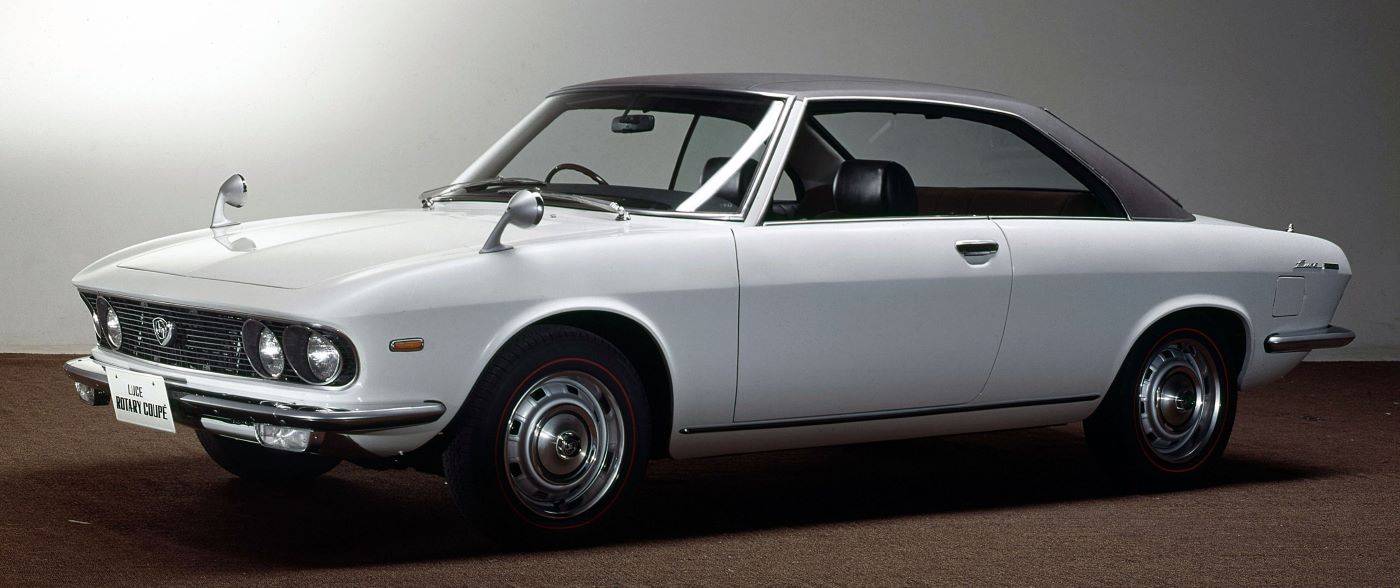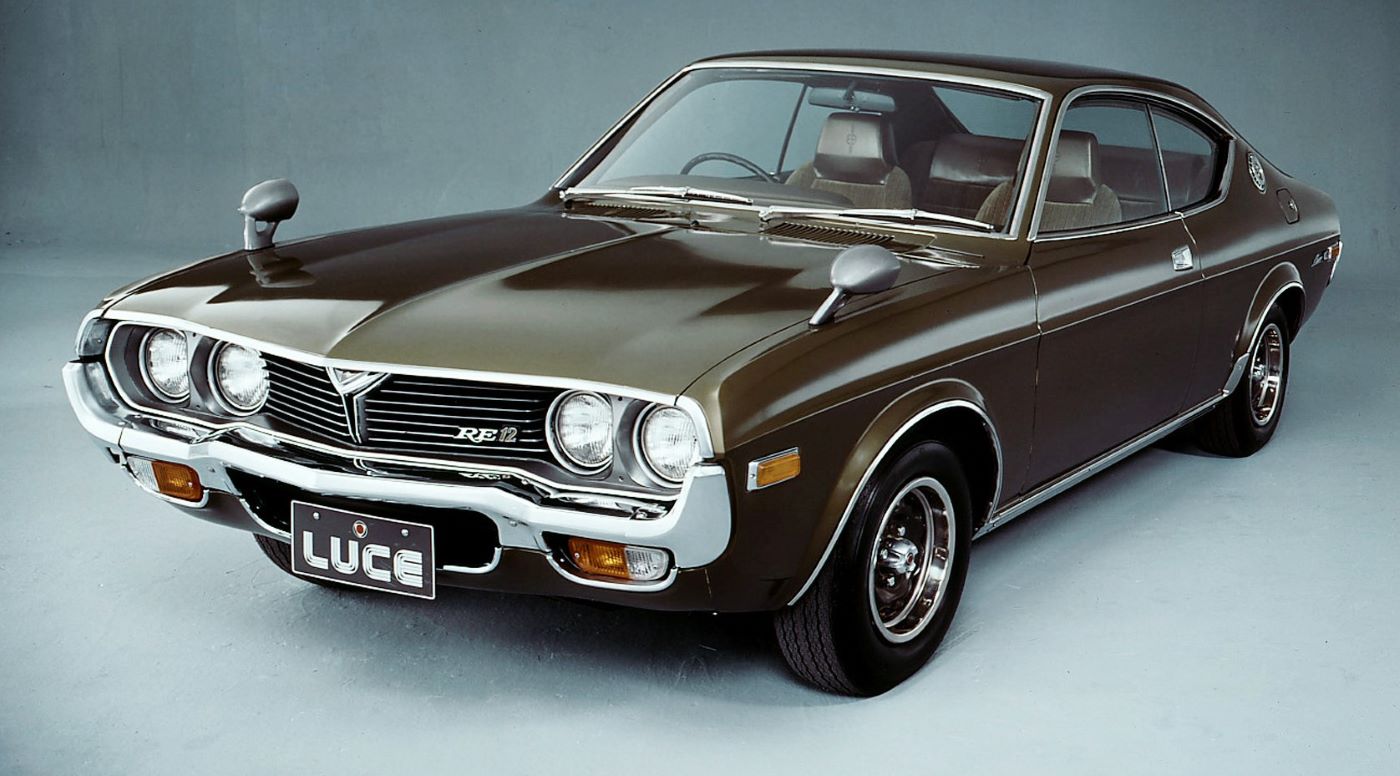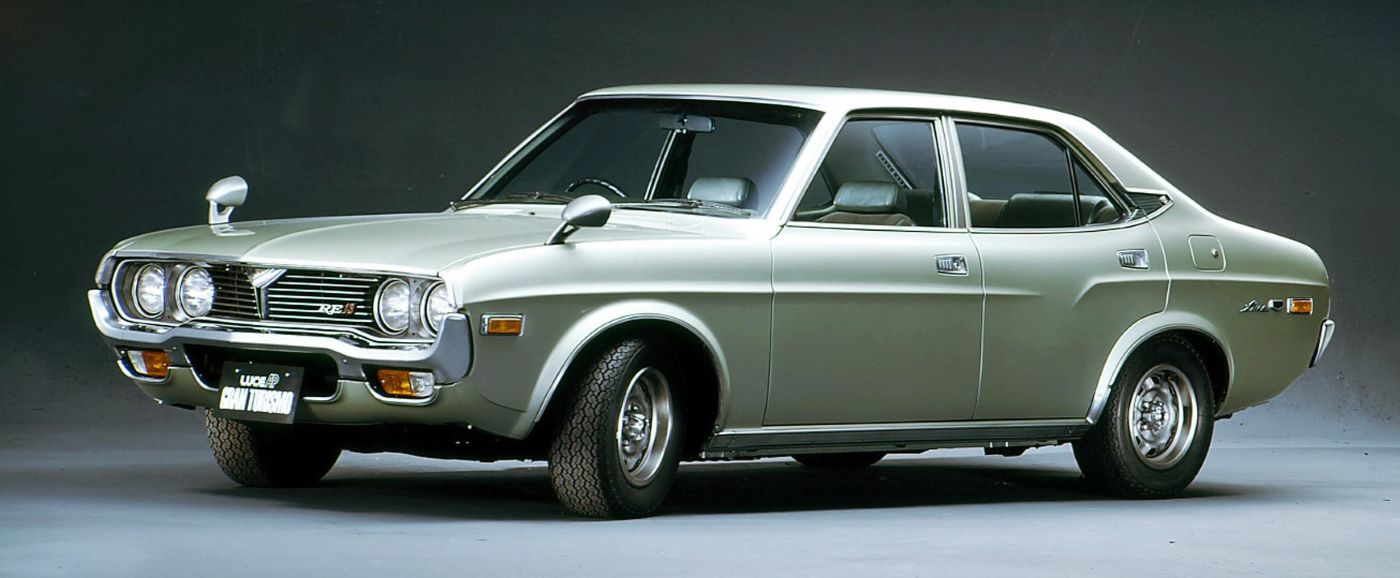
Luce: The leading light of Mazda’s innovation
Mazda, which launched its first passenger car, the R360 Coupe, on the market in 1960, introduced the Carol in 1962 and Familia (Mazda 800) in 1964, and steadily developed models from this base thereafter.
On August 20, 1966, Mazda introduced a flagship model known as the Luce. The body style, characterized by an “A line” connecting front, center and rear pillars, was based on a Bertone original design from Italy, which was modified by Mazda’s designers to suit the company’s tastes.
The model name, taken from the Italian “Luce” — meaning bright or shiny — was fitting for such a modern, elegantly designed car that radiated a dazzling personality and was far superior to the Japanese car standard at the time. It was the only car in the 1,500cc class with a spacious interior capable of accommodating six occupants. Among its many notable advances, the Luce featured a newly designed SOHC engine (first in this class) that produced 78ps maximum power and took the car to maximum speed of 150 km/h.


The hardtop coupe version of the Luce with a 655cc x 2 new rotary engine, known as the Luce Rotary Coupe, was launched three years later in October 1969. Mazda used the compactness of the new rotary engine – which delivered 126ps maximum power and accelerated the car to 190 km/h maximum speed – for the first time here in a front-engine front-wheel-drive format. In an age when new company employees straight from university earned just 30,000 yen a month, the Luce Rotary Coupe, costing from 1.45 to 1.75 million yen, was dubbed “Lord of the Road” for its high price, beautiful body and high-speed performance. The car was shown not only at auto dealers but also at 35 major department stores throughout Japan, and gained a reputation for its elegant form. With its distinctive personality, the Luce Rotary Coupe entered the luxury personal car market that was emerging at the time.


LA2/LA3 series (1972–1977)


The Mazda Luce AP (also known as the 2nd generation Luce) debuted in 1972 as a significant evolution of Mazda’s executive sedan offering. The “AP” stands for “Anti-Pollution,” indicating the car’s compliance with increasingly stringent emission regulations of the time. Here’s a closer look at the Mazda Luce AP1800:
Overview of the Mazda Luce AP1800 (2nd Generation):
- Manufacturer: Mazda
- Model: Luce AP1800
- Debut: 1972
- Body Styles: Available as a sedan, coupé, and station wagon.
- Designer: Giorgetto Giugiaro from Italdesign, one of the most prominent automotive designers of the era.
- Engine: The AP1800 variant was powered by an 1.8-liter (1769 cc) inline-4 engine.
- Power Output: Approximately 100-105 horsepower.
- Transmission: Available with a 4-speed manual or 3-speed automatic transmission.
- Layout: Front-engine, rear-wheel-drive (FR layout).
- Exterior Design: The Luce AP featured a modern and elegant design, with clean lines and a refined profile that distinguished it from its competitors. The design reflected European influences, which were in vogue at the time.
- Interior: The Luce AP1800 offered a spacious and comfortable interior, with higher-end trims featuring luxurious materials and advanced features for the time, such as air conditioning and power windows.
- Technology: In keeping with its “Anti-Pollution” designation, the car included features to reduce emissions, aligning with global trends towards more environmentally conscious vehicle designs.
- The Mazda Luce AP1800 was positioned as an executive or mid-to-large size sedan, aimed at customers looking for a blend of performance, style, and comfort. It competed with other Japanese sedans of the time, such as the Toyota Crown and Nissan Cedric, as well as some European imports.
- The Mazda Luce, particularly in its 2nd generation, is remembered for its sophisticated design and engineering. While not as widely known outside Japan as some of Mazda’s other models, the Luce AP1800 played a crucial role in establishing Mazda as a maker of high-quality executive cars.
- The design influence of Giorgetto Giugiaro can be seen in the car’s clean, modern lines, which have helped it age gracefully and maintain a certain level of collector interest today.
The Mazda Luce AP1800 represents a significant chapter in Mazda’s history, blending innovative design, solid engineering, and a focus on emissions reduction, a forward-thinking approach for the time.

The 1975 Mazda Luce represents the third generation of Mazda’s executive sedan, known for its blend of style, comfort, and advanced engineering. This generation of the Luce was also known as the Mazda 929 in some export markets. Here’s a detailed look at the 1975 Mazda Luce:
Overview of the 1975 Mazda Luce (3rd Generation):
- Manufacturer: Mazda
- Model: Luce (also known as Mazda 929 in some markets)
- Debut: 1975
- Body Styles: Available as a sedan and coupé.
- Design: The design of the third-generation Luce was more angular and modern, in line with the styling trends of the mid-1970s. It featured a more squared-off front end with a prominent grille and rectangular headlights.
Engine and Performance:
- Engine Options:
- 1.8-Liter Inline-4: This engine, similar to the one used in earlier Luce models, continued to be an option, providing reliable performance.
- 2.0-Liter Inline-4: The 2.0-liter engine was a more powerful option, delivering better performance and suited for those seeking a bit more power.
- 13B Rotary Engine: The Luce was also offered with Mazda’s renowned 13B rotary engine, which provided smooth power delivery and was a key part of Mazda’s identity at the time.
- Power Output: Depending on the engine, power ranged from approximately 90 to 125 horsepower.
- Transmission: Available with a 4-speed manual, 5-speed manual, or 3-speed automatic transmission.
- Layout: Front-engine, rear-wheel-drive (FR layout).
Design and Features:
- Exterior Design: The 1975 Luce featured a boxier, more formal design compared to its predecessor, with sharper lines and a more substantial appearance. The grille was large and rectangular, flanked by square headlights, which gave it a distinct, stately look.
- Interior: The interior of the 1975 Luce was designed with comfort in mind, offering spacious seating, high-quality materials, and a range of features such as air conditioning, power windows, and upgraded audio systems in higher trims.
- Suspension: The Luce featured independent front suspension and a solid rear axle with leaf springs, providing a comfortable ride.
Market Position:
- The 1975 Mazda Luce was positioned as an executive sedan, targeting buyers looking for a blend of luxury, comfort, and advanced technology. It competed against other large sedans in Japan and internationally, such as the Toyota Crown, Nissan Cedric, and European imports like the Mercedes-Benz W114.

You must be logged in to post a comment.